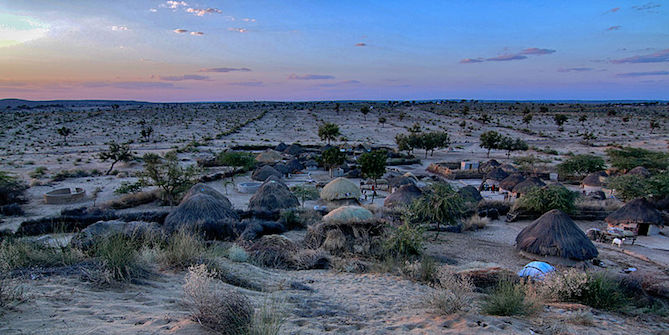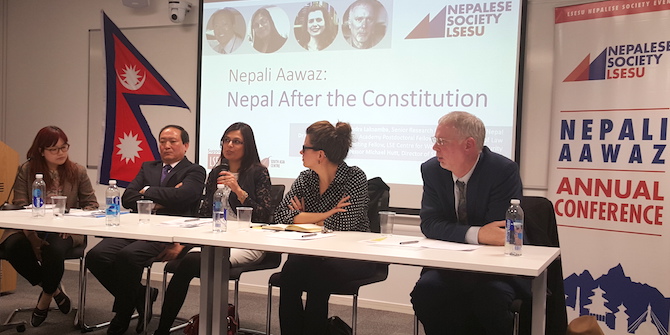 At the LSE India Summit 2017 Amita Baviskar moderated the water security panel. After the session, Rebecca Bowers spoke to her about her research on access to water and the associated hierarchies that exist in India.
At the LSE India Summit 2017 Amita Baviskar moderated the water security panel. After the session, Rebecca Bowers spoke to her about her research on access to water and the associated hierarchies that exist in India.
RB: What would you say are the biggest challenges are in supplying India’s growing population with access to adequate water?
AB: I think the biggest challenge is that of quality. The quality of the water that many Indians drink is often so poor that they develop gastrointestinal infections and diseases. As a result, even if people have enough to eat, they are not able to digest that food and gain the nutrients from it.
So the first thing that we need is to be able to provide people with safe drinking water and meeting that challenge is going to mean a whole set of actions and initiatives. First of all, we have to deal with the way in which water is contaminated by sewage of different kinds. All our cities and towns have inadequate facilities for treating wastewater and so it makes its way into the nearest stream or river or pond where people draw water from, or it contaminates ground water. It’s quite astonishing despite the staggering amounts of money that have been spent on sewage treatment there has been very little commitment to it, so much of that money has been literally down the drain.
Another issue is industrial pollution, where again we have a really weak system of regulation, oversight and punishment. We need all of those if we are going to make sure that our industries don’t end up harming the environment.
You’ve written frequently about the politics of water and its role in widely varying aspects of everyday life for different communities. How might these intersectionalities of say, caste, class, religion and gender affect access to water?
As in anywhere in the world, access to water in India is something that depends on who you are, the region you belong to, the community you come from, your place within that community and so on. In some ways though, it’s ironic that the same poor people that happen to come together can secure access to water that’s been denied to them in other contexts. Villagers who have been pushed out of their rural homes because agriculture is no longer viable due to a lack of water find that they are able to command access to water when they come to the city as poor migrants because they are numerous enough. They might be impoverished, but the ability to count, in the government’s eyes, as a political constituency means that they are able to do better in terms of water access. So yes, caste, class, gender, all of these matter.
The burden of dealing with the task of collecting water of course falls on women much more than on men and that’s part of the reason why water is not prioritised as much as a basic need as it ought to be. But despite that, we see that it is possible to overcome these factors if people are able to come together and get support from activists and NGOs and make their case, and in some cases the courts have also been supportive of their struggles.
In Delhi the Aam Aadmi party has introduced new policies in providing access to water. How successful would you say that has been and is this something perhaps that other state governments should be attempting?
By making water and electricity free in very small amounts, the Aam Aadmi party have in a way reaffirmed the fact that water is a basic right and that people should have it regardless of their economic or political status. However, they haven’t been equally effective in affirming the right of people to clean water – to water you can drink from the tap. As a result we find the burden of disease is much higher for poorer people and if they can afford it, they end up spending a lot of money on small home filters or subscribing to bottled water services and so on.
We see some new attempts to deliver clean water to poor people, for instance water ATMs, but there is still no sense of whether that is a form of water provisioning that can be scaled up and provided to everybody. It is a little unfortunate that these forms of water are still treated as a commodity of which you have to purchase rather than something that you are entitled to, and that is a public good. But I do think that the Aam Aadmi party has done something that a lot of other states and cities are watching with interest.

Would you say that India’s growing cities are being placed ahead in the hierarchy for water in comparison to rural areas?
Oh absolutely. There’s no doubt at all that cities are able to command more water. Primarily because they are dense clusters of people and they count as these people happen to vote. So cities have gained water at the expense of the countryside, most blatantly I think in the case of the Sardar Sarovar dam in western India. This was a dam that originally set out to provide water primarily for drinking and for irrigation in rural areas but we find that the bulk of it has actually gone to provide drinking water to urban centres. So the irony is that the river Sabarmati is now flowing with water in Ahmedabad not because the Sabarmati has been unexpectedly rejuvenated, but because water from the Narmada has been transferred there. So riverfront development, water for cities, which includes not just water for drinking and domestic use, but also water for industry, water for entertainment, these ‘non-basic’ uses of water have tended to get met because they happen to be in cities.
That’s a huge inequity and one that is probably going to be ironically compounded as I mentioned before. People are leaving rural areas because the scarcity of water has made agriculture that much harder, they move to the cities, and the ways in which the cities are siphoning water from the countryside makes the problem that much worse. So we have a vicious circle at work here.
You can watch the India @ 70: LSE India Summit Water Security Panel here, and a short video of Professor Baviskar discussing India’s water crisis here.
This article gives the views of the authors, and not the position of the South Asia @ LSE blog, nor of the London School of Economics. Please read our comments policy before posting.
About the Authors
 Amita Baviskar is Professor at the Institute of Economic Growth, Delhi. Her research focuses on the cultural politics of environment and development.
Amita Baviskar is Professor at the Institute of Economic Growth, Delhi. Her research focuses on the cultural politics of environment and development.
 Rebecca Bowers is a final year PhD student in the Anthropology Department at the London School of Economics. Rebecca’s research explores the lives of female construction workers and their families in Bengaluru, India.
Rebecca Bowers is a final year PhD student in the Anthropology Department at the London School of Economics. Rebecca’s research explores the lives of female construction workers and their families in Bengaluru, India.







